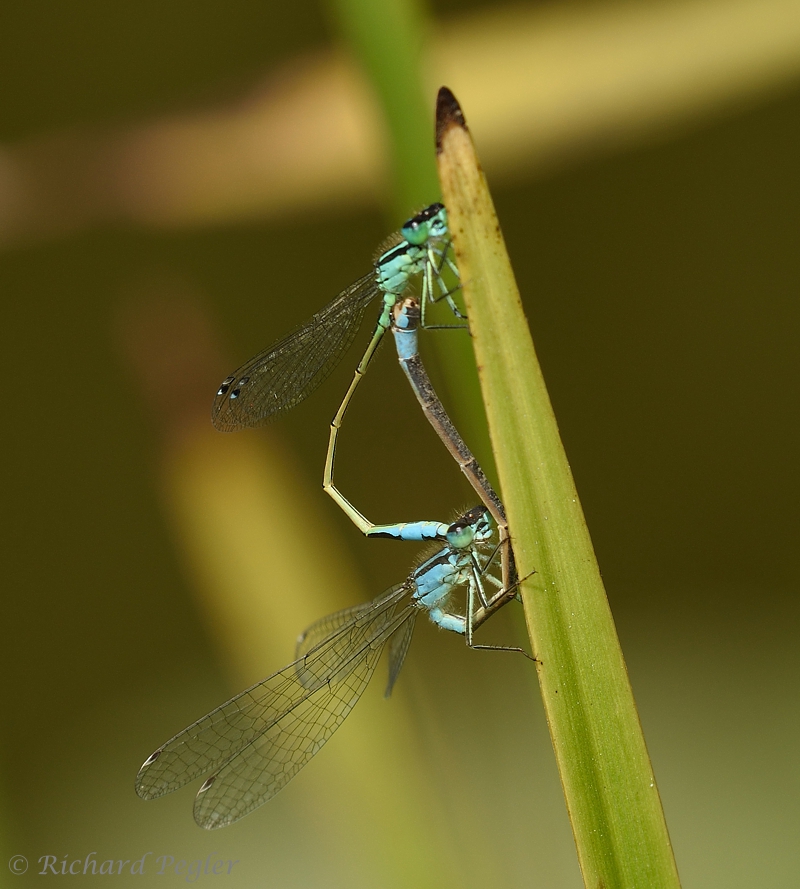This blog post brings me a little more up-to-date, having had a couple of reasonably fruitful local visits in the past week or so.
On this occasion, I decided to make a return visit to Heather Lake. This place is great for Emperor dragonflies in the middle of summer, but I'd not visited this late in the season before, and wondered if I might find Migrant Hawker here.
Having parked my car, and started out on the footpath that leads to the lake, I immediately spotted a Speckled Wood butterfly in a photographable position.
 |
| Speckled Wood (Pararge aegeria) - near Heather Lake |
Exiting the wooded section of the path, there is a narrow watercourse running to the lake. I often see many damselflies here, but on this day I saw none. However, having reached the lake, I immediately spotted a Migrant Hawker which settled in reeds on the far (west) bank.
 |
| Migrant Hawker (Aeshna mixta) (male) - Heather lake |
I took a slow pass up the east side of the lake and soon found another Migrant Hawker in flight, and this one settled too - but this time where I could get at it!
 |
| Migrant Hawker (Aeshna mixta) (male) - Heather lake |
A little further along there was a male Common Darter. I had started to think this had been a bad year for this species, but now I am seeing many more of them. The second image shows the eyes, and the part of the thorax 'powerhouse' which drives the wings, that give these amazing insects the ability to spot and intercept, rather than chase, their prey.
 |
| Common Darter (Sympetrum striolatum) (male) - Heather Lake |
There were a few damselflies at the south end of the lake, but I spent little time with them. Here, however, is one of our most common species.
 |
| Common Blue Damselfly (Enallagma cyathigerum) (male) - Heather Lake |
Round on the west side of the lake I saw a Brown Hawker looking as if it was trying to find somewhere to roost. Eventually it did but, sadly, in a place where it was impossible to get near to without being torn to ribbons by a 5-metre dense wall of brambles. This was the best that I could do.
 |
| Brown Hawker (Aeshna grandis) (male) - Heather Lake |
Arriving at the point where I'd seen my first Migrant Hawker of the day land, I spotted a Small Copper butterfly. This species is said to be in worrying decline, but I think I have seen as many of these in the past ten days as I have in the whole of the rest of my life! This one has patches of electric blue on its hind wings which, I think, makes it f. caeruleo-punctata.
 |
| Small Copper (Lycaena phlaeas f. caeruleo-punctata) (female) - Heather Lake |
I'd done a full circuit of the lake and decided to have another look in the area that I'd had the close-up views of the Migrant Hawker. This time I found one that was patrolling the area, and occasionally having an altercation with another of its kind, whereupon it would disappear for a while before returning to keep guard over its territory, and to check me out. This gave me some opportunities for flight shots.
 |
| Migrant Hawker (Aeshna mixta) (male) - Heather lake |
After a while, this dragonfly departed, and I turned my attention to a pair of Common Darter that were busy ovipositing out in the middle of the lake. I was hoping that they'd come closer, but they didn't.
 |
| Common Darter (Sympetrum striolatum) (male + female, ovipositing) - Heather Lake |
A quick look to see if I could find anything else, only yielded another perched Common Darter, and then another in flight.
 |
| Common Darter (Sympetrum striolatum) (male) - Heather Lake |
It was time to head homeward as there's only so much waving around of a heavy camera and 50-500 lens, trying to get flight shots, that my arms can do before giving up! It had been an enjoyable and rewarding session for me.
Thank you for dropping by. Unless something else crops up, I suspect that my next post will feature butterflies and a damselfly or two - or I might find time for a resumé of summer wildlife in our garden.































































